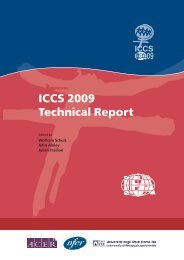Teacher Education and Development Study in Mathematics - IEA
Teacher Education and Development Study in Mathematics - IEA
Teacher Education and Development Study in Mathematics - IEA
You also want an ePaper? Increase the reach of your titles
YUMPU automatically turns print PDFs into web optimized ePapers that Google loves.
172<br />
TEACHER PAY AND STUDENT MATHEMATICS ACHIEVEMENT<br />
United States<br />
Composition of the teacher labor force<br />
The teach<strong>in</strong>g force <strong>in</strong> elementary <strong>and</strong> secondary schools (public plus private) has grown<br />
steadily <strong>in</strong> the United States, from 2.3 million teachers <strong>in</strong> 1970 to 2.5 million <strong>in</strong> 1980,<br />
<strong>and</strong> from 2.7 million <strong>in</strong> 1990 through to 3.3 million <strong>in</strong> 2000, <strong>and</strong> on to 3.5 million<br />
<strong>in</strong> 2005 (National Center for <strong>Education</strong>al Statistics (NCES), 2004, Table 4). Figure<br />
70 shows this trend. About 40% of the total K–12 teach<strong>in</strong>g force <strong>in</strong> the 1990s was <strong>in</strong><br />
secondary education. The proportion of teachers <strong>in</strong> private schools <strong>in</strong>creased slightly<br />
<strong>in</strong> this period, from 10% to 11%.<br />
The number of teachers has <strong>in</strong>creased more rapidly than the number of students <strong>in</strong><br />
schools: the student–teacher ratio decl<strong>in</strong>ed from just under 22.5 students for every<br />
teacher <strong>in</strong> 1970 to just over 18.5 students per teacher <strong>in</strong> 1980, just under 17 per teacher<br />
<strong>in</strong> 1990, 16 <strong>in</strong> 2000, <strong>and</strong> 15.5 <strong>in</strong> 2005. This downwards trend is expected to cont<strong>in</strong>ue<br />
<strong>in</strong> the com<strong>in</strong>g years (NCES, 2004, Table 64). In the 10-year period encompass<strong>in</strong>g 1970<br />
to 1980, the drop <strong>in</strong> the student–teacher ratio exceeded the drop <strong>in</strong> ratio <strong>in</strong> the 25<br />
years follow<strong>in</strong>g 1980, even though the <strong>in</strong>crease <strong>in</strong> the number of teachers was smaller,<br />
proportionately, than <strong>in</strong> the period 1980 to 2005.<br />
Figure 70: United States, Public <strong>and</strong> Private School <strong>Teacher</strong>s, 1980 to 2010 (Projected)<br />
3,800<br />
3,600<br />
3,400<br />
Number of <strong>Teacher</strong>s<br />
3,200<br />
3,000<br />
2,800<br />
2,600<br />
2,400<br />
2,200<br />
2,000<br />
1980 1982 1984 1986 1988 1990 1992 1994 1996 1998 2000 2002 2004 2006 2008 2010<br />
Year<br />
Source: NCES (2004, Table 4).<br />
<strong>Teacher</strong> education <strong>and</strong> recruitment<br />
<strong>Teacher</strong> education, recruitment, <strong>and</strong> pay are highly decentralized <strong>in</strong> the United States.<br />
Each state sets its own requirements for teacher certification, although some states have<br />
provisions for “alternative” or “emergency” certification schemes that allow people who<br />
have not met all state requirements to teach, usually on a temporary basis. All states<br />
require certified teachers to have completed a Bachelor’s degree program that <strong>in</strong>cludes<br />
both subject matter <strong>and</strong> pedagogical studies for an <strong>in</strong>itial credential. Most teachers<br />
major <strong>in</strong> education (primary school teachers) or <strong>in</strong> a subject matter <strong>and</strong> take sufficient<br />
education courses to obta<strong>in</strong> certification. Many states have additional requirements for<br />
second- <strong>and</strong> third-stage certification, such as additional courses, a Master’s degree, <strong>and</strong><br />
exam<strong>in</strong>ations.

















